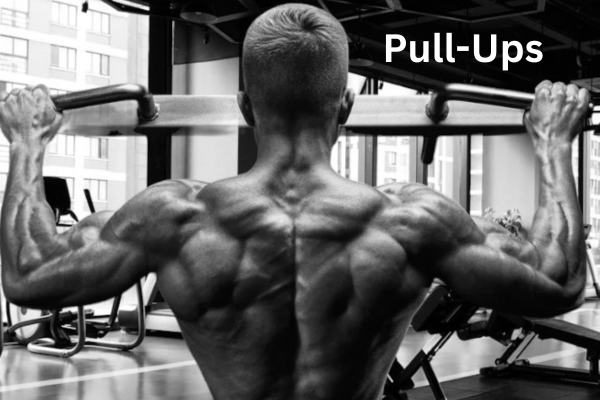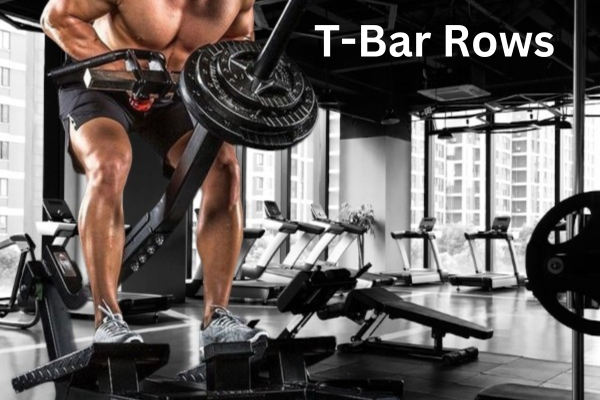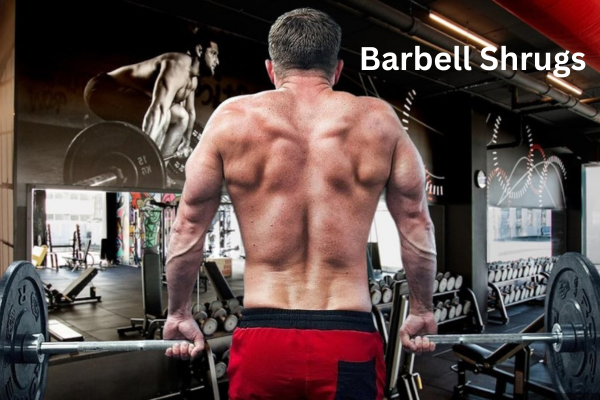Top 5 Compound Exercises for Back in 2024: Bulk your Back

A strong and well-developed back not only enhances your physique but also contributes to overall strength and functionality. While isolation exercises have their place in a workout routine, compound exercises for back take the spotlight for their ability to engage multiple muscle groups simultaneously, leading to efficient and effective workouts. In this article, we delve into the top five compound exercises for the back, exploring their benefits, proper execution, and why they should be staples in your training regimen.
Why Compound Exercises for Back Are Better?
Compound exercises for back are revered for their efficiency, functionality, and muscle-building prowess. Here’s why they stand out:
Efficiency: Compound movements engage multiple muscle groups simultaneously, delivering comprehensive workouts in less time. Deadlifts, for instance, target not only the back but also the legs, core, and grip strength.
Functional Strength: Mimicking everyday movements, compound exercises enhance real-life functionality. Pull-ups and rows, for example, mirror actions like lifting groceries or pulling oneself up over obstacles.
Increased Muscle Activation: Compound exercises recruit a larger number of muscle fibers, fostering greater muscle activation and development. This leads to more balanced and functional muscle growth.
Caloric Expenditure: With their multi-muscle engagement, compound exercises burn more calories, aiding in fat loss and improving cardiovascular health and endurance.
Hormonal Response: Compound movements stimulate the release of muscle-building hormones like testosterone and growth hormone, facilitating significant gains in strength and muscle mass.
Functional Core Engagement: Many compound exercises require core stabilization, strengthening the entire core region and improving posture, stability, and injury prevention.
Progressive Overload: Easily adaptable for progression, compound exercises allow for continual muscle challenge by increasing weight, reps, or sets, making them suitable for all fitness levels.
Top 5 Best Compound Exercises for Back
1. Deadlifts

Deadlifts are renowned as the king of compound exercises, targeting not only the back but also the hamstrings, glutes, and core muscles. This powerhouse movement builds overall strength and enhances muscle mass, making it a must-have in any back-focused workout routine.
Benefits:
- Builds strength in the entire posterior chain.
- Improves grip strength and overall athleticism.
- Enhances spinal erector and upper back muscle development.
How to Perform:
- Start by standing with your feet hip-width apart, toes pointing forward, and the barbell resting on the floor in front of you.
- Bend at your hips and knees, keeping your back straight and chest lifted, to grip the barbell with an overhand or mixed grip.
- Engage your core and drive through your heels as you lift the barbell, extending your hips and knees simultaneously until you’re standing tall.
- Lower the barbell back down with control, maintaining proper form throughout the movement.
Variations:
- Sumo Deadlifts: Widen your stance and grip the barbell with your hands inside your knees. This variation emphasizes the inner thighs and reduces stress on the lower back.
- Romanian Deadlifts: Keep your legs straighter and hinge at the hips while lowering the barbell towards the floor. This variation targets the hamstrings and glutes while still engaging the back muscles.
- Single-Leg Deadlifts: Hold a dumbbell or kettlebell in one hand and lift the opposite leg behind you as you hinge at the hips and lower the weight towards the floor. This variation improves balance and unilateral strength.
2. Pull-Ups:
Pull-ups are a classic bodyweight exercise, among other compound exercises for back, that primarily targets the latissimus dorsi, or lats, along with engaging the biceps, shoulders, and upper back muscles. This compound movement not only strengthens the back but also improves overall upper body pulling strength and muscle definition.

Benefits:
- Targets the lats for a wider and more defined back.
- Enhances grip strength and overall upper body pulling power.
- Can be scaled for different fitness levels by adjusting grip width or using assistance bands.
How to Perform:
- With your palms facing away from you and your hands somewhat wider than shoulder-width apart, start by grabbing an overhead bar.
- With your arms outstretched and your core tight, hang from the bar.
- Pull your body upward by driving your elbows down and back, aiming to bring your chin above the bar.
- Take control and lower yourself back down to finish one repetition.
Variations:
- Chin-Ups: Grip the bar with your palms facing towards you, hands shoulder-width apart. This variation emphasizes the biceps and lower lats.
- Wide-Grip Pull-Ups: Grip the bar wider than shoulder-width apart with palms facing away from you. This variation targets the outer lats and helps widen the back.
- Assisted Pull-Ups: Use resistance bands or an assisted pull-up machine to reduce bodyweight and assist with the movement. This variation is suitable for beginners or those working towards their first unassisted pull-up.
3. Bent-over Rows:
Bent-over rows are a staple exercise, among other compound exercises for back, that effectively targets the muscles of the upper and middle back, including the rhomboids, traps, and rear delts, while also engaging the biceps and forearms. This movement is essential for building a strong and well-rounded back.

Benefits:
- Targets the muscles of the upper and middle back for improved posture and shoulder health.
- Strengthens the grip and forearm muscles.
- Provides balance to the pushing movements in your workout routine.
How to Perform:
- Stand with your feet shoulder-width apart, holding a barbell or dumbbells with an overhand grip.
- Hinge at your hips to bend forward until your torso is nearly parallel to the floor, keeping your back straight and core engaged.
- Pull the weight towards your lower ribcage by retracting your shoulder blades and driving your elbows back.
- With controll drop the weight back down to finish one repetition.
Variations:
- Dumbbell Rows: Perform rows with dumbbells instead of a barbell to allow for a greater range of motion and unilateral strength development.
- Pendlay Rows: Start with the barbell on the floor between each repetition, resetting your position to maintain strict form and minimize momentum.
- Inverted Rows: Use a suspension trainer or bar positioned at waist height to perform rows while lying underneath. This variation is beneficial for those unable to perform traditional bent-over rows due to lower back issues.
4. T-Bar Rows:
T-bar rows are a part of compound exercises for back performed using a T-bar machine or a landmine attachment. This exrecise, among other compound exercises for back, emphasizes the muscles of the upper back, including the traps, rhomboids, and rear delts, while also engaging the lats and biceps.

Benefits:
- Targets the upper back muscles for improved strength and definition.
- Allows for a more controlled range of motion compared to free-weight rows.
- Provides variation to your back workout routine for continued progress.
How to Perform:
- Position yourself in front of the T-bar machine or landmine attachment, straddling the bar with your feet shoulder-width apart.
- Grip the handles or the bar with both hands, keeping your back straight and core engaged.
- Pull the weight towards your lower ribcage by retracting your shoulder blades and driving your elbows back.
- Maintaining good form throughout the exercise, carefully lower the weight back down.
Variations:
- Chest-Supported T-Bar Rows: Lie face down on an incline bench with your chest supported and row the weight towards your lower ribcage. This variation reduces strain on the lower back and allows for a more isolated contraction of the back muscles.
- One-Arm T-Bar Rows: Perform rows with one hand while stabilizing yourself with the other hand on a bench or rack for support. This variation improves unilateral strength and balance.
- Wide-Grip T-Bar Rows: Grip the handles or bar wider than shoulder-width apart to target the outer lats and emphasize width in the back.
5. Barbell Shrugs:
Barbell shrugs primarily target the trapezius muscles, which run along the upper back and neck.

Benefits:
- Barbell shrugs help improve shoulder stability and posture.
- Barbell Shrugs strengthens the upper trapezius muscles for better neck and upper back support.
How to Perform:
- Using an overhand grip, hold a barbell in front of your thighs while standing with your feet hip-width apart.
- Shrug your shoulders towards your ears as high as possible, squeezing the trapezius muscles.
- Lower your shoulders back down in a controlled motion to complete one rep.
Variations:
- Dumbbell Shrugs: Perform shrugs with dumbbells instead of a barbell to allow for a greater range of motion and unilateral work.
- Behind-the-Back Barbell Shrugs: Hold the barbell behind your back with an overhand grip, targeting the rear portion of the traps more effectively.
- Isometric Holds: Hold the top position of the shrug for an extended period to increase time under tension and enhance muscle endurance.
Conclusion for Compound Exercises for Back
Incorporating compound exercises for back into your workout routine is essential for building strength, muscle mass, and overall athleticism. Deadlifts, pull-ups, bent-over rows, T-bar rows, and barbell rows are five powerhouse movements that target different muscle groups within the back, providing a comprehensive approach to back training. By mastering these exercises and incorporating them into your workouts consistently, you can achieve a stronger, more muscular back and unlock your full athletic potential.
If you wish to read more similar articles. Click here
Frequently Asked Questions:
While compound exercises for back are highly effective for building overall strength and muscle mass in the back, incorporating isolation exercises can help target specific muscles and address any imbalances. A combination of compound and isolation exercises often yields the best results.
It’s recommended to include compound exercises for back in your workout routine 1-2 times per week, depending on your training frequency and goals. Allow for adequate rest and recovery between sessions to maximize muscle growth and strength gains.
If you have lower back pain, it’s essential to consult with a healthcare professional before engaging in any exercise routine. While compound exercises for back like deadlifts and bent-over rows can strengthen the lower back when performed with proper form, modifications may be necessary to avoid exacerbating existing pain or injuries.
